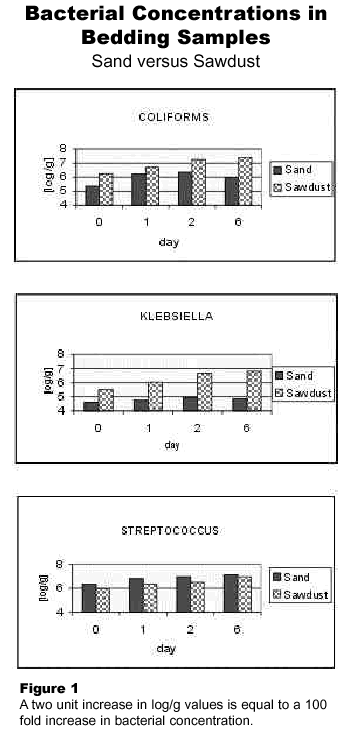Gosia Zdanowicz and Jim Shelford
Increasingly, dairy producers are turning to inorganic types of bedding, mainly sand, in an attempt to decrease the rates of environmental mastitis in their herds. Is sand bedding really decreasing the numbers of pathogenic bacteria in the cows’ environment? This is the question addressed in our research project.
Environmental mastitis is caused by bacteria found in the soil, manure and bedding. Dairy cows are constantly exposed to them; therefore, reducing the concentrations of those pathogens in the barn is one of the ways to minimize the rates of intramammary infections. Mastitis is a very costly disease as it leads to reduced milk production and quality, treatment and medication costs, loss of animals and premature culling of animals. Therefore, a lower incidence of mastitis in the herd has an enormous economic impact.
It is commonly believed that inorganic bedding does not support the growth of bacteria as well as organic bedding does. However, the effects of sand bedding on the bacterial populations in the bedding and on the teat ends have not been well researched, so there is a need to determine if there is a relationship between bacterial counts and bedding. The objectives of our project were to determine and compare bacteria populations of mastitis-causing organisms in tow different kinds of bedding materials and on teat ends.
Two groups of eight cows each were housed in the Centre’s free-stall barn, one group with sand bedding and the other with sawdust bedding. Cows were assigned to each treatment group balanced by parity, stage of lactation, intramammary-infection status at the beginning of the trial and teat ends score. Each group of cows was moved to the other treatment after 3 weeks. Fresh bedding was added every 7 days but manure was removed daily as needed to keep stalls visibly clean and dry. Cow activities were recorded for 24 hours prior to the sample collection on a time-lapsed video recorder to estimate the time spent lying down for each treatment pen and for each stall.
Bedding samples were collected four times a week from the back one-third of each stall. Teat swabs and milk samples were taken three times a week during the morning milking. Bedding samples were analyzed for dry matter content and pH. All collected samples (bedding, teat swabs, and milk) were analyzed for the concentrations of three major groups of mastitis-causing bacteria: coliforms, Streptococci spp., and Klebsiella spp. Our results showed that there are more coliforms and Klebsiella bacteria in sawdust bedding than in sand bedding. Surprisingly, sand bedding contained as many Streptococci as sawdust bedding. Also, the pattern of bacterial counts over time was different for the two kinds of bedding.

Bacterial populations in sawdust increased steadily for the first 2 days after adding fresh bedding and then stabilized. However, there was no defined pattern for the bacterial counts in sand bedding. Figure 1 illustrates the differences in bacterial counts in sand and sawdust bedding for the three classes of bacteria.
Test swab samples showed very similar results to bedding samples. We found more coliforms and Klebsiella bacteria on the teat ends of cows housed on sawdust bedding than those housed on sand bedding. However, cows housed on sand had more Streptococcus bacteria on their teat ends than cows housed on sawdust. Over the period of a week, as stalls became increasingly wetter and dirtier, ‘sawdust’ cows had higher bacterial counts on their teat ends. Bacterial populations were steadily increasing on teat ends of animals housed on sawdust. However, this was not the case for cows housed on sand bedding. Again, there was no clearly defined pattern here, similar to the bedding samples.
Milk samples were collected to determine the bacterial populations in the milk in the teat canal of a cow. However, we did not find any significant bacterial counts in milk samples. One of the reasons is that our study was a short-term project with only 6 weeks of data collection and only 16 animals used.
In summary, our work shows that there are higher counts of Coliforms and Klebsiella bacteria in sawdust bedding and on the teat ends of cows housed on sawdust than in sand and on teat ends of cows housed on sand. We have found similar levels of Streptococcus in sand and in sawdust bedding. Moreover, Streptococcus populations were higher on the teat ends of cows housed on sand than on sawdust.
Watch this newsletter for information about this research and other work from the UBC Dairy Centre. Contact Dr. Jim Shelford, Professor in Animal Nutrition at shelford@interchange.ubc.ca. This article is based on thesis research by MSc. Student Gosia Zdanowicz.
Next Month: Dehorning Dairy Calves
